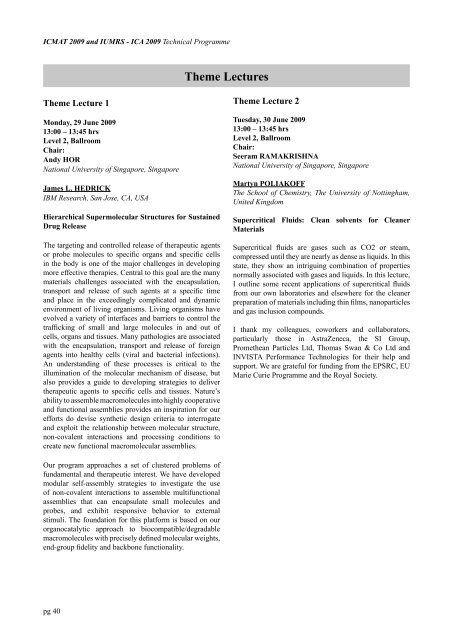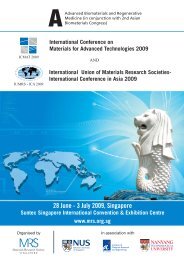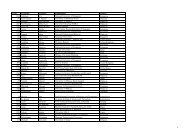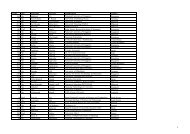Technical Programme - Materials Research Society of Singapore ...
Technical Programme - Materials Research Society of Singapore ...
Technical Programme - Materials Research Society of Singapore ...
You also want an ePaper? Increase the reach of your titles
YUMPU automatically turns print PDFs into web optimized ePapers that Google loves.
ICMAT 2009 and IUMRS - ICA 2009 <strong>Technical</strong> <strong>Programme</strong><br />
Theme Lecture 1<br />
Monday, 29 June 2009<br />
13:00 – 13:45 hrs<br />
Level 2, Ballroom<br />
Chair:<br />
Andy HOR<br />
National University <strong>of</strong> <strong>Singapore</strong>, <strong>Singapore</strong><br />
James L. HEDRICK<br />
IBM <strong>Research</strong>, San Jose, CA, USA<br />
Hierarchical Supermolecular Structures for Sustained<br />
Drug Release<br />
The targeting and controlled release <strong>of</strong> therapeutic agents<br />
or probe molecules to specifi c organs and specifi c cells<br />
in the body is one <strong>of</strong> the major challenges in developing<br />
more effective therapies. Central to this goal are the many<br />
materials challenges associated with the encapsulation,<br />
transport and release <strong>of</strong> such agents at a specifi c time<br />
and place in the exceedingly complicated and dynamic<br />
environment <strong>of</strong> living organisms. Living organisms have<br />
evolved a variety <strong>of</strong> interfaces and barriers to control the<br />
traffi cking <strong>of</strong> small and large molecules in and out <strong>of</strong><br />
cells, organs and tissues. Many pathologies are associated<br />
with the encapsulation, transport and release <strong>of</strong> foreign<br />
agents into healthy cells (viral and bacterial infections).<br />
An understanding <strong>of</strong> these processes is critical to the<br />
illumination <strong>of</strong> the molecular mechanism <strong>of</strong> disease, but<br />
also provides a guide to developing strategies to deliver<br />
therapeutic agents to specifi c cells and tissues. Nature’s<br />
ability to assemble macromolecules into highly cooperative<br />
and functional assemblies provides an inspiration for our<br />
efforts do devise synthetic design criteria to interrogate<br />
and exploit the relationship between molecular structure,<br />
non-covalent interactions and processing conditions to<br />
create new functional macromolecular assemblies.<br />
Our program approaches a set <strong>of</strong> clustered problems <strong>of</strong><br />
fundamental and therapeutic interest. We have developed<br />
modular self-assembly strategies to investigate the use<br />
<strong>of</strong> non-covalent interactions to assemble multifunctional<br />
assemblies that can encapsulate small molecules and<br />
probes, and exhibit responsive behavior to external<br />
stimuli. The foundation for this platform is based on our<br />
organocatalytic approach to biocompatible/degradable<br />
macromolecules with precisely defi ned molecular weights,<br />
end-group fi delity and backbone functionality.<br />
pg 40<br />
Theme Lectures<br />
Theme Lecture 2<br />
Tuesday, 30 June 2009<br />
13:00 – 13:45 hrs<br />
Level 2, Ballroom<br />
Chair:<br />
Seeram RAMAKRISHNA<br />
National University <strong>of</strong> <strong>Singapore</strong>, <strong>Singapore</strong><br />
Martyn POLIAKOFF<br />
The School <strong>of</strong> Chemistry, The University <strong>of</strong> Nottingham,<br />
United Kingdom<br />
Supercritical Fluids: Clean solvents for Cleaner<br />
<strong>Materials</strong><br />
Supercritical fl uids are gases such as CO2 or steam,<br />
compressed until they are nearly as dense as liquids. In this<br />
state, they show an intriguing combination <strong>of</strong> properties<br />
normally associated with gases and liquids. In this lecture,<br />
I outline some recent applications <strong>of</strong> supercritical fl uids<br />
from our own laboratories and elsewhere for the cleaner<br />
preparation <strong>of</strong> materials including thin fi lms, nanoparticles<br />
and gas inclusion compounds.<br />
I thank my colleagues, coworkers and collaborators,<br />
particularly those in AstraZeneca, the SI Group,<br />
Promethean Particles Ltd, Thomas Swan & Co Ltd and<br />
INVISTA Performance Technologies for their help and<br />
support. We are grateful for funding from the EPSRC, EU<br />
Marie Curie <strong>Programme</strong> and the Royal <strong>Society</strong>.






